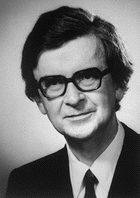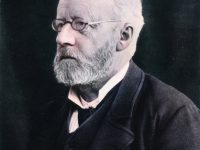
Niels Kaj Jerne (1911-1994)
On December 23, 1911, Danish immunologist Niels Kaj Jerne was born. Jerne shared the Nobel Prize in Physiology or Medicine in 1984 with Georges J. F. Köhler and César Milstein “for theories concerning the specificity in development and control of the immune system and the discovery of the principle for production of monoclonal antibodies“.
“An immune system of enormous complexity is present in all vertebrate animals. When we place a population of lymphocytes from such an animal in appropriate tissue culture fluid, and when we add an antigen, the lymphocytes will produce specific antibody molecules, in the absense of any nerve cells. I find it astonishing that the immune system embodies a degree of complexity which suggests some more or less superficial though striking analogies with human language, and that this cognitive system has evolved and functions without assistance of the brain.” — Niels K. Jerne
Early Years
Niels Jerne was born in London, where his parents had moved in 1910 from the Danish island of Fanø. His father was the inventor and industrialist Hans Jessen Jerne (1877–1950). During the First World War his parents moved to the Netherlands, where his father acquired a refrigerated storehouse in Rotterdam and later became reasonably wealthy, and Jerne spent his youth in Rotterdam, where he received his Baccalaureate at the University of Rotterdam in 1928.[1] After studying physics for two years at the Leiden University Niels Jerne moved to Copenhagen and changed his studies to the field of medicine. He graduated from the University of Copenhagen with a degree in medicine in 1947, and in 1951 he was awarded the doctorate for a thesis titled “A Study of Avidity Based on Rabbit Skin Responses to Diphtheria Toxin-Antitoxin Mixtures“. One of the unexpected findings of the dissertation was that avidity increases in the course of immunization.[3]
Antibody Formation
From 1943 to 1956 Niels Jerne was a research worker at the Danish National Serum Institute and during this time he formulated a theory on antibody formation. It is said that Jerne got his revolutionary scientific idea while bicycling across the Langebro bridge in Copenhagen on his way home from work. Actually, he was struck in the summer of 1954 by an experiment that, in his eyes, demonstrated the existence of specific antibodies without the prior presence of a corresponding antigen. A few weeks later he formulated a theory of antibody formation that could explain, he thought, a whole array of serological and immunological phenomena, including the avidity increase. All possible kinds of specific antibody molecules already exist in normal serum, he stated, and one of these specific molecules fits, “by chance,” any given antigen, not necessarily exactly but approximately. The intruding antigen selects such specific fitting antibody molecules and transports them to antibody-producing cells, where they are further multiplied and released into the bloodstream.[3]
The existence of preformed antibodies had been highly disputed in immunology for more than half a century. In 1897 Paul Ehrlich had speculated that all cells in the body carry preformed molecular groups, so-called side chains, which were assumed to play a part in the absorption of specific nutritional substances.[6] Intruding antigens — toxins, for example — would also be recognized by such side chains, which were supposed to be released into the bloodstream as specific antibodies. After Karl Landsteiner’s experiments, beginning in the 1910s, with synthetic haptens Ehrlich’s theory fell into disrepute. Whatever particular antigen was synthesized in the chemist’s laboratory, it gave rise to a specific antibody response. It was considered impossible for organisms to have all these specific molecules in stock waiting for whatever might intrude. Instead, from the middle of the 1930s varieties of template theories became dominant among serologists and immunologists who claimed that the specificity of antibodies was determined de novo by the antigen. The chemically most sophisticated of these template theories was put forward by Linus Pauling, who suggested that specific antibodies were formed when normal, nonspecific globulin molecules that had not yet received their final tertiary configuration wrapped around antigen molecules and so took on a specific, complementary structure.[3]
Work at the World Health Organization
The antibody formation theory gave Niels Jerne international recognition and in 1956 Jerne went to work for the World Health Organization in Geneva, where he served as the Head of the Sections of Biological Standards and of Immunology. He held this post for six years until moving to the United States and the University of Pittsburgh in 1962 to work as Professor of Microbiology and Chairman of the Department of Microbiology for four years. Niels Jerne continued to do work for the World Health Organization as a member of the Expert Advisory Panel of Immunology from 1962 and onwards.
Frankfurt and Basel
In 1966 Jerne moved back to Europe and took up the position of Professor of Experimental Therapy at the Johann Wolfgang Goethe University in Frankfurt. From 1966 to 1969 he was the Director of the Paul-Ehrlich-Institut, also in Frankfurt. In 1969 Jerne again switched jobs, this time to Basel in Switzerland, where he was the Director of the Basel Institute for Immunology until his retirement in 1980. During the 1970s and 1980s Jerne was a pioneer in the development of immune network theory. 1984 Nobel Prize in Physiology or Medicine with Georges J.F. Köhler (AAI ’85) and César Milstein (AAI ’79) “for theories concerning the specificity in development and control of the immune system and the discovery of the principle for production of monoclonal antibodies.”[4]
Niels Jerne’s Achievements and Legacy
Jerne’s main theories challenged widely held views concerning the development of antibodies and laid new foundations for contemporary immunology. Jerne published his first theory, the “natural-selection theory” of antibody formation, in 1955. At the time, immunologists believed that specific antibodies were nonexistent until their corresponding antigens entered the system and served as templates upon which the antibodies were created. Another leading theory at the time held that antigens introduced into cells were modified by enzymes and that repeated antigen exposure caused replication of antibodies that were partial replicas of these enzyme-modified antigens. Jerne challenged both of these notions, hypothesizing that all antibodies are formed during fetal development and are present in the body from birth. He suggested that when an antigen enters the body, it binds to a pre-existing complementary antibody and stimulates the rapid production of identical antibodies.
With his second theory, first set forth in 1971, Jerne sought to explain how the immune system learns to distinguish self from non-self. Immunologists at the time thought that the body’s self-tolerance could not be inherited as a standard pattern but must be learned. Jerne theorized that this “learning” takes place in the thymus gland in the upper chest, where different populations of lymphocytes are exposed to histocompatibility antigens. Lymphocytes that recognize self-antigens are suppressed, whereas non-self lymphocytes, which have accumulated spontaneous mutations, develop and multiply into lymphocytes that can detect foreign antigens.
Network Theory
In 1974, Jerne published his third and most significant theory, his “network theory,” which revolutionized the way immunologists thought about adaptive immunity and immune regulation. Jerne posited that an antibody can bind to the antigen-specific variable region of another antibody and elicit production of anti-antibodies, a process, which, in turn, triggers a successive cascade of anti-anti-antibody production. This cascade broadens the diversity of the antibody population, and the network attains a state of balance under normal conditions, which can be perturbed and restored during additional antigen exposures.[4]
Niels Jerne died on October 7, 1994, aged 82.
Adam Martin, 30. Immunology 1 – Diversity, Specificity, & B cells, [8]
References and Further Reading:
- [1] Niels Kaj Jerne, Biographical, at Nobelprize.org
- [2] Niels K. Jerne, Danish immunologist, at Britannica onlione
- [3] “Jerne, Niels Kaj.” Complete Dictionary of Scientific Biography. . Encyclopedia.com.
- [4] Niels K. Jerne, M.D., at The American Association of Immunologist
- [5] T. Söderqvist: The Life and Work of Niels Kay Jerne as a Source of Ethical Reflection
- [6] Paul Ehrlich and the Chemotherapy, SciHi Blog
- [7] Niels Kaj Jerne at Wikidata
- [8] Adam Martin, 30. Immunology 1 – Diversity, Specificity, & B cells, MIT 7.016 Introductory Biology, Fall 2018, MIT OpenCourseWare @ youtube
- [9] Timeline of Nobel Laureates on Physiology and Medicine, via Wikidata





